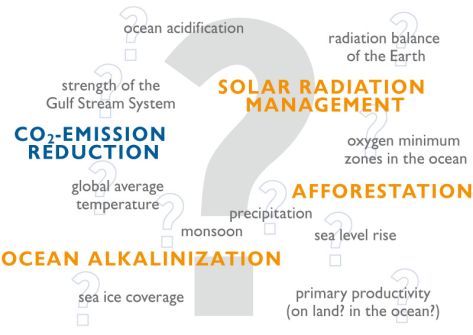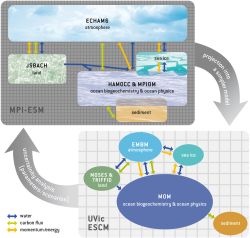
ComparCE-2
Comparative assessment of potential impacts, side effects and uncertainties of Climate Engineering measures and emission-reduction efforts
- Prof. Dr. Andreas Oschlies // GEOMAR Helmholtz Centre for Ocean Research Kiel
- Dr. Tatjana Ilyina // Max Planck Institute for Meteorology
- Dr. Julia Pongratz // Max Planck Institute for Meteorology
- Dr. Hauke Schmidt // Max Planck Institute for Meteorology
- Dr. Sebastian Sonntag // Max Planck Institute for Meteorology
- Dr. Miriam Ferrer Gonzalez // Max Planck Institute for Meteorology
- Dr. Giang Tran // // GEOMAR Helmholtz Centre for Ocean Research Kiel
- Dr. Friederike Fröb // Max Planck Institute for Meteorology
Project Goal
The key goal of the project is an objective and comprehensive assessment of potential effects, side-effects, and uncertainties of different Climate Engineering (CE) methods and emission reduction measures. This will be done using simulations with Earth system models. Special focus lies on scenarios combining different CE measures, detection of signals and uncertainty assessments.
Different CE methods (e.g., afforestation, radiation management, ocean alkalinity enhancement) will be simulated under various CO2 emission scenarios. Effects and side-effects will be compared by using different metrics (Fig. 1).

C O R E Q U E E S T I O N S
|
||
|
||
|
||
|
||
|
||
Methods

To simulate the large-scale deployment of different CE schemes two Earth system models will be used: the relatively simple, computationally fast University of Victoria Earth System Climate Model (UVic ESCM) and the more complex but computationally more costly Max Planck Institute Earth System Model (MPI-ESM).
Legend:
ECHAM6 - European Centre for Medium-Range Weather Forecasts Hamburg Version 6
JSBACH - Jena Scheme for Biosphere-Atmosphere Coupling in Hamburg
MPIOM - Max-Plank-Institute Ocean General Circulation Model
HAMOCC - Hamburg Ocean Carbon Cycle
EMBM - Energy Moisture Balance Model
MOSES - Met Office Surface Exchange Scheme
TRIFID - Top-down Representation of Interactive Foliage and Flora Including Dynamics
MOM2 - Modular Ocean Model (http://climate.uvic.ca/model/common/manual2.2.ps)
Role in the Priority Programme
1. Metrics for the assessment of CE effects are developed in close cooperation with other projects.
2. Model simulations of portfolio scenarios (with combinations of different CE methods) are performed and provided.
3. A methodology for detection and attribution consistently applicable to land-, ocean- and atmosphere-based CE is developed and applied to portfolio scenarios.
4. Uncertainties in the model results are investigated quantitatively.
